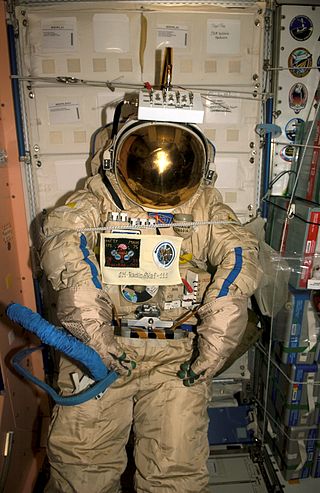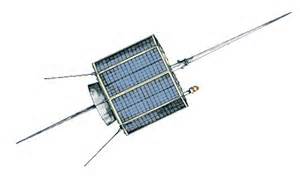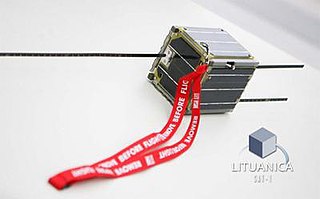AMSAT is a name for amateur radio satellite organizations worldwide, but in particular the Radio Amateur Satellite Corporation (AMSAT) with headquarters at Washington, D.C. AMSAT organizations design, build, arrange launches for, and then operate (command) satellites carrying amateur radio payloads, including the OSCAR series of satellites. Other informally affiliated national organizations exist, such as AMSAT Germany (AMSAT-DL) and AMSAT Japan (JAMSAT).
AMSAT-OSCAR-40, also known as AO-40 or simply OSCAR 40, was the on-orbit designation of an amateur radio satellite of the OSCAR series. Prior to launch, the spacecraft was known as Phase 3D or "P3D". AO-40 was built by AMSAT.
UoSAT-2, which is also known as UO-11 and OSCAR-11, is a British satellite orbiting in Low Earth Orbit. The satellite functions as an amateur radio transmitter and was built at the University of Surrey. It launched into orbit in March 1984 and remains orbital and active, though unstable with irregular periods of transmission. All of the Analog telemetry channels have failed, making telemetry from OSCAR 11 useless. The satellite was still heard transmitting telemetry in 2015, thirty years after launch.
HAMSAT also known as HAMSAT INDIA, VU2SAT and VO-52 is a microsatellite weighing 42.5 kilograms (93.7 lb), providing amateur radio satellite communications services for Indian and international amateur radio operators. This satellite carries the in-orbit designation of VO-52, and is an OSCAR series satellite.

SuitSat was a retired Russian Orlan space suit with a radio transmitter mounted on its helmet, used as a hand-launched satellite.
SumbandilaSat, was a South African micro Earth observation satellite, launched on 17 September 2009 on a Soyuz-2 launch vehicle from the Baikonur Cosmodrome. The first part of the name, Sumbandila, is from the Venda language and means "lead the way".
UoSAT-1, also known as UoSAT-OSCAR 9 (UO-9), was a British amateur radio satellite which orbited Earth. It was built at the University of Surrey and launched into low Earth orbit on 6 October 1981. It exceeded its anticipated two-year orbital lifespan by six years, having received signals on 13 October 1989, before re-entering the atmosphere.

AMSAT-OSCAR 7, or AO-7, is the second Phase 2 amateur radio satellite constructed by the Radio Amateur Satellite Corporation or AMSAT. It was launched into Low Earth Orbit on November 15, 1974 and remained operational until a battery failure in 1981. After 21 years of apparent silence, the satellite was heard again on June 21, 2002 – 27 years after launch. At that time the public learned that the satellite had remained intermittently functional and was used surreptitiously for communication by the anticommunist opposition Fighting Solidarity during martial law in Poland.
SSETI Express was the first spacecraft to be designed and built by European students and was launched by the European Space Agency. SSETI Express is a small spacecraft, similar in size and shape to a washing machine. On board the student-built spacecraft were three CubeSat picosatellites, extremely small satellites weighing around one kg each. These were deployed one hour and forty minutes after launch. Twenty-one university groups, working from locations spread across Europe and with very different cultural backgrounds, worked together via the internet to jointly create the satellite. The expected lifetime of the mission was planned to be 2 months. SSETI Express encountered an unusually fast mission development: less than 18 months from kick-off in January 2004 to flight-readiness.
AMSAT-OSCAR 16, also known as AO-16 and PACSAT, is the in-orbit name designation of an amateur radio satellite of the OSCAR series. It was built by AMSAT and was launched on 22 January 1990 from Kourou, French Guiana on an Ariane 4 launch vehicle. It is in sun synchronous low Earth orbit.

OSCAR 3 is the third amateur radio satellite launched by Project OSCAR into Low Earth Orbit. OSCAR 3 was launched March 9, 1965 by a Thor-DM21 Agena D launcher from Vandenberg Air Force Base, Lompoc, California. The satellite, massing 15 kg (33 lb), was launched piggyback with seven United States Air Force satellites. Though the satellite's active life was limited to sixteen days due to battery failure, OSCAR 3 relayed 176 messages from 98 stations in North America and Europe during its 274 orbit life-time -- the first amateur satellite to relay signals from Earth. As of 2023, it is still in orbit.

LituanicaSAT-1 was one of the first two Lithuanian satellites. It was launched along with the second Cygnus spacecraft and 28 Flock-1 CubeSats aboard an Antares 120 carrier rocket flying from Pad 0B at the Mid-Atlantic Regional Spaceport on Wallops Island to the International Space Station. The launch was scheduled to occur in December 2013, but later was rescheduled to 9 January 2014 and occurred then. The satellite was broadcasting greetings of Lithuanian president, Mrs. Dalia Grybauskaitė. The satellite was deployed from the International Space Station via the NanoRacks CubeSat Deployer on February 28, 2014. All LituanicaSAT-1 subsystems have been turned on, tested and proved to be working properly. The mission is considered a complete success by its team of engineers. The mission ended upon the reentry and disintegration of the satellite on July 28, 2014.

FUNcube-1 is a complete educational single unit CubeSat satellite with the goal of enthusing and educating young people about radio, space, physics and electronics. It is part of a program which aims to launch more of these educational CubeSats. It is the first satellite with outreach as its primary mission.
Fox-1D, AO-92 or AMSAT OSCAR 92 is an American amateur radio satellite. Fox-1D is a 1U CubeSat developed and built by AMSAT-NA. Fox-1D carries a single-channel transponder for mode U/V in FM. Fox-1D has an L-band converter, which allows the FM transponder to be switched on an uplink in the 23 centimetres (9.1 in) band.
Fox-1B, AO-91 or AMSAT OSCAR 91 is a United States amateur radio satellite. It is a 1U Cubesat, was built by the AMSAT-NA and carries a single-channel transponder for FM radio. The satellite has a whip antenna for the 70 cm and 23 cm bands (uplink), and a second antenna for the 2 m band (downlink). Fox-1B is the second amateur radio satellite of the Fox series of AMSAT North America.
Fox-1A, AO-85 or AMSAT OSCAR 85 is an American amateur radio satellite. It is a 1U Cubesat, was built by the AMSAT-NA and carries a single-channel transponder for FM radio. The satellite has one rod antenna each for the 70 centimetres (28 in) and 2 metres bands. To enable a satellite launch under NASA's Educational Launch of Nanosatellites (ELaNa) program, the satellite continues to carry a Penn State University student experiment.
ParkinsonSAT, PSat or Naval Academy OSCAR 84 is a U.S. technology demonstration satellite and an amateur radio satellite for Packet Radio. It was built at the U.S. Naval Academy and was planned as a double satellite. The name ParkinsonSAT was chosen in honor of Bradford Parkinson, the father of the GPS system. After successful launch, the satellite was assigned the OSCAR number 84.
Weber-OSCAR 18 is an American amateur radio satellite.

AMSAT OSCAR 10 was a star-shaped German AMSAT micro-satellite. It was launched on 16 June 1983 from Guiana Space Centre, Kourou, French Guiana, with an Ariane 1 rocket. This was changed to a Molniya orbit using an attached booster, to support world-wide amateur satellite communications.
Fox-1E, AO-109, Evolution or AMSAT OSCAR 109 is an American amateur radio satellite. It is a 1U Cubesat, was built by the AMSAT-NA and carries a single-channel transponder for FM radio. Fox-1E is the fifth amateur radio satellite of the Fox series of AMSAT North America.







